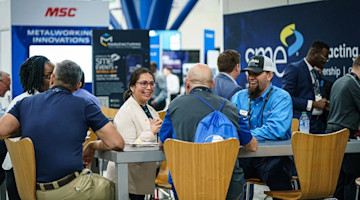Experts in leading manufacturing markets sat down with AMT to share their thoughts on the growth opportunities and challenges in the aerospace, machine shop, and additive manufacturing (AM) segments. These experts will expand upon their outlooks and provide more actionable direction for business decision makers at AMT’s upcoming MTForecast 2023 conference, held Oct. 4-6 in Detroit.
Aerospace
Eric Brothers, senior editor at Aerospace Manufacturing and Design magazine for the past 10 years, says the commercial aviation market has bounced back to pre-pandemic levels, providing a lot of growth opportunities for parts and assembly suppliers.
Brothers notes that at the recent Paris Air Show, leading players Boeing and Airbus announced sales projections to be in the trillions of dollars over the next 20 years. That not only impacts the manufacturers of production parts but also those supplying the maintenance and repair of those aircraft.
He also points to sustainability as a major aviation industry trend. With OEMs expected to reduce their carbon footprint, they will expect the same from their Tier 1 through Tier 4 suppliers. The European Union announced efforts to reach net zero carbon emissions by 2050, creating big challenges for aerospace. Brothers expects the aerospace market to respond by switching to sustainable aviation fuel, but also designing more hybrid electric and hydrogen-powered aircraft.
“Aircraft manufacturers will be working to cut carbon emissions wherever they can, which trickles down to their suppliers’ machine tools using less energy. Parts suppliers all the way up to the airlines using the planes will need to contribute to these emission reduction goals,” Brothers says.
According to Brothers, the defense industry is spending a lot of money as it expands into lower-cost expendable aircraft such as drones. Suppliers that can demonstrate cybersecurity readiness — a high priority for defense — will have an advantage over competitors.
Machine shops
Roger Atkins, president at the National Tooling & Machining Association, predicts that with the uncertainty about an upcoming recession, some markets that machine shops serve will fare better than others. Overall, however, he says it’s a great time to be in the manufacturing industry.
Atkins observes that as the labor shortage becomes the new normal, shops taking advantage of automation will have a competitive edge.
“One of the quickest ways to do more work with the people you [have] today is to automate, but in the long term, shops need to commit to upskilling current employees and get the message out to local schools,” Atkins says. “You can’t just hang a ‘Now Hiring’ sign in front of your shop like you once could. Shops that don’t change may not survive.”
Atkins cites onshoring as a big growth opportunity for small and medium-sized machine shops that can reduce their costs by streamlining operations.
“Smaller shops don’t have to cut prices to compete with bigger shops, they just need to reduce costs to be more competitive,” Atkins notes. “Technology in machine tools, cutting tools, and automation are changing rapidly. Those that make an effort to improve their efficiency will be able to get in on reshoring opportunities.”
Additive manufacturing
Over the last five years, AM has been a big growth area, thanks to an influx of venture capital and consolidation through mergers and acquisitions. Mark Huber, analyst at AMT, says the greatest opportunities within AM include applying hybrid processes as part of a “factory of the future” mindset.
“Robotics and automation are vital components for connecting additive, subtractive, and inspection,” Huber explains. “The large capital influx is funding companies developing each of these technologies.”
Although there’s potential to use AM for more high-scale production applications, the lack of standards and qualifications are slowing down wider adoption. According to Huber, the markets with the best traction in AM so far are the most price insensitive ones: aerospace, defense, medical, and dental. Automotive has great potential in the near term as costs continue to decline.
With various AM processes at different steps of development, Huber notes that it can be hard for manufacturers to decide the best time to adopt a particular AM technology. AMT members looking for more answers about AM can talk to the AMT research team at MTForecast 2023 or by filling out a research intake form online.
Economic Outlooks
Hear more forecast details from Brothers, Atkins, and Huber, as well as other industry experts in the energy, semiconductor, automotive, and medical markets at MTForecast 2023. Plus, get the latest financial outlooks from these well-respected industry economists:
Mark Killion, director of U.S. industries at Oxford Economics
Alan Beaulieu, president of ITR Economics
Martin Lavelle, senior business economist at Federal Reserve Bank of Chicago
Discover expanding business sectors and where the opportunities are by registering AMT’s MTForecast 2023 conference on the event website.






